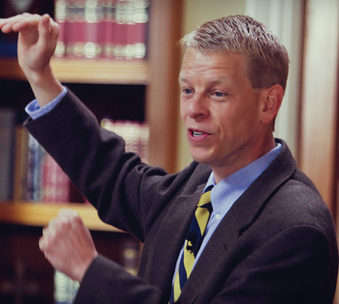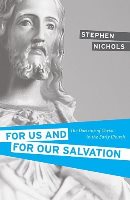Welcome back to Books At a Glance as we continue our brief discussions tracking out the big picture of the Protestant Reformation. I’m Fred Zaspel here with Steve Nichols again talking this time about John Knox and the Scottish Reformation.
Who was John Knox? And how is he important for the Scottish Reformation and the Reformation era? Is that a big enough question for you? (laughing)
Nichols:
Yes. Let’s see if we can summarize this guy’s life in a few moments. John Knox is a huge figure in the Reformation. For one thing, I’d love to back up here and say there really needs to be a movie made about his life. First, he was a bodyguard so we’ve got to throw that into the mix. So this is at the beginning of the Scottish Reformation. There was a figure, George Wishart, and John Knox served as his bodyguard. So I don’t know if Knox hung out at the gym or if he was just a trustworthy person, but here he is serving as his bodyguard. There’s always the white hats and black hats, and so the black hat in this story is Cardinal Beaton. And Cardinal Beaton, and this is Scotland, we all know Braveheart, right? So, Beaton is taken and he is executed by those on the side of the Reformation. And, as a result of that, the Roman Catholic sorties would sweep in and make significant arrests. Knox gets arrested and gets sentenced to a galley ship. And so, here again, it’s almost an adventure story, not a church history figure. So, he’s on the galley ship, and then later when Bloody Mary comes to the throne, all these reformers in England and up in Scotland are exiled, so Knox gets kicked out and ends up in Calvin’s Geneva. There he is so impressed by not only the theological reforms, but even the civil reforms were brought to the city. He sees this and his famous comment is that Geneva was this perfect school for Christ. When he is able to go back to Scotland, he wants to bring to his native land what Calvin did for the city of Geneva, and thus his famous line, “Give me Scotland, or I die.” Knox comes back and is joined by some associates. There are six of them, and I find this interesting, they are all named John. That’s just such a quirk of church history. So, you get the six Johns together and together they write the Scots Confession. And that’s the beginning of the Kirk, the Scottish Kirk, the national Church of Scotland. Very quickly the Reformation spreads through Scotland and this was all at the hands of John Knox. We speak of the reformers as having courage and boldness, and John Knox is Exhibit A—this fiery preacher in Scotland proclaiming the gospel and seeing how the gospel transforms lives
Zaspel:
Just a curious question—Knox in Geneva and with Calvin. How did they communicate? What language?
Nichols:
Latin. This is the interesting thing about these scholars, they all knew Latin. You can just imagine them having these conversations in Latin. There’s a building next to St. Pierre’s Cathedral. There is this square in old Geneva, it’s a walled city, very charming, and there’s St. Pierre’s Cathedral and next to it is a building called the Auditoire, or the Auditorium. Calvin gave that to the Scottish and British refugees to use as their church. They actually had church services in English, while Calvin was having his church services next door in French in St. Pierre‘s Cathedral. So, there you go, French and English side-by-side.
Zaspel:
It’s been said that Mary Queen of Scots was more afraid of John Knox’s prayers than all the armies of Europe? What was that all about in context? Why did she say that?
Nichols:
Yes, that’s a fascinating relationship. Of course, this is not Bloody Mary, this is Mary Queen of Scots. One of the things that Knox observed in Geneva is that it’s Calvin in the pulpit, Calvin in the church and the theological reforms, but then it’s the Council that ran the city, called the Consistory, and that’s where we are also seeing the social reforms and the civil outworking of the transformation of the gospel. As Knox is observing that, he’s realizing that in order for the reforms to come to Scotland, and for Scotland to have this transformation, it’s going to be both Monarch and Church in terms of bringing this about. So to say that Knox was a burr under the saddle of Mary, would be an understatement. But Knox saw her as having an obligation in her role as a monarch to bring the biblical principles and the moral law to bear upon her subjects and to have an environment in which that were the case. He is very critical of her when she is not doing that, and when she fails in what he sees as her obligation as the monarch. There are stories of him being in her presence and chastising her so much she leaves in tears, and so that’s what behind Mary’s fear of John Knox, as we would say.
Zaspel:
Let me back up a bit. What was Knox’s relationship to John Calvin? How was he influenced by Calvin?
Nichols:
The years he spent in exile it Geneva were really spent observing what Calvin was up to. And in many ways, I think what we see there is, as soon as he gets back he is able to write the Scots Confession. This is really codifying what he saw in Calvin and what he learned from Calvin both as a preacher and as a church administrator, as it were, in establishing this new true church. I think what impressed Knox from the teaching of Calvin the most was if you go back to Calvin’s initial stay at Geneva, he gets kicked out. And a few weeks before he gets kicked out he writes a letter and in the letter he says, “I fear that the people want a preacher and not a pastor.” What Calvin meant by that was… and this is kind of interesting. When Geneva became a reformed city, it actually voted to become reformed. The land-owning men who formed the citizenry of Geneva at the time gathered in the town square and they literally raised their hands and voted to become a reformed city. This is the beauty of the Swiss city state. What Calvin wanted Geneva to learn was that being reformed is not simply raising your hand and voting; but you’re recognizing that the gospel takes root in your soul and in your very being and transforms your life. And that’s what he meant by saying his job was a pastor. Down in the south, they say that you’re starting to meddle—you’re not preaching, you’re meddling. And I think that’s what Knox learned. As you see him, that’s the backbone of what he’s trying to do in Scotland.
Zaspel:
What was Knox’s legacy or lasting influence in Scotland?
Nichols:
You know, it’s sort of sad. If you were to say, what’s Knox’s influence today, it’s nonexistent. And in many ways, it’s sort of a love/hate relationship with him. He’s not a national hero. In fact, where he is actually buried, is a parking lot; and there’s a carpark, as they say, over his gravesite. So that’s sort of a nice metaphor. There’s a Free Church of Scotland which is really carrying on the legacy of the church that Knox founded, because liberalism is rampant in the Church of Scotland. But the Free Church is sometimes called the Wee Frees, because they are so small. They are approximately maybe 1% of the population of Scotland. We see this in Luther’s Germany; we see it in Calvin’s Geneva; it’s almost as if a new darkness has descended upon these lands where the gospel once broke forth. Where Knox lived on, of course, is in Presbyterianism. And it was really in the Scottish Reformation that we have the Presbyterian Church being born and that is Knox’s legacy.
Zaspel:
We’re talking to Dr. Stephen Nichols about the Protestant Reformation. Steve is President of Reformation Bible College and author of The Reformation: How a Monk and a Mallet Changed the World—as well as many other church history related books that you’ll want to check out on this page. Steve will be with us one more time to talk about the Spread of the Reformation in Europe. We hope you’ll join us then.
Steve, many thanks for talking to us again today.
Nichols:
My pleasure: thanks for having me.
Editor’s Note: Below are some titles by Dr. Stephen Nichols that will be of interest to you!
The Reformation: How a Monk and a Mallet Changed the World
Paperback
Kindle
Martin Luther: A Guided Tour of His Life and Thought (Guided Tour of Church History)
Paperback
Kindle
The Church History ABCs: Augustine and 25 Other Heroes of the Faith
Paperback
Kindle
Welcome to the Story: Reading, Loving, and Living God’s Word
Paperback
Kindle
Jesus Made in America: A Cultural History from the Puritans to “The Passion of the Christ”
Paperback
Kindle
For Us and for Our Salvation: The Doctrine of Christ in the Early Church
Paperback
Kindle
Ancient Word, Changing Worlds: The Doctrine of Scripture in a Modern Age
Paperback
Kindle
Pages From Church History: A Guided Tour of Christian Classics
Paperback
Kindle
Heaven on Earth: Capturing Jonathan Edwards’s Vision of Living in Between
Paperback
Kindle
J. Gresham Machen: A Guided Tour of His Life and Thought (Guided Tour of Church History)
Paperback
Kindle
An Absolute Sort of Certainty: The Holy Spirit and the Apologetics of Jonathan Edwards
Paperback

